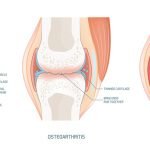If you’ve got arthritis or are concerned that you might receive a diagnosis of arthritis because of family history, you might want to be extra careful about what you eat. Of course, you need to choose a nutritious diet that helps you shed any excess weight since that strains your joints and can exacerbate arthritis pain. But according to new research, what foods you eat are also important because some foods appear to increase the risk of osteoarthritis.
The study, which took place at the Oklahoma Medical Research Foundation in Oklahoma City, found that the consumption of certain dietary components is associated with a greater risk of developing osteoarthritis, even when there are no differences in weight.1 Donovan, Elise L.; et al. “Independent effects of dietary fat and sucrose content on chondrocyte metabolism and osteoarthritis pathology in mice.” Disease Models & Mechanisms. 16 July 2018. Accessed 12 August 2018. http://dmm.biologists.org/content/early/2018/07/13/dmm.034827. For this investigation, the subjects were not humans but instead laboratory mice.
The mice were randomly divided into groups and provided with different high-fat diets to attain information on how obesity can contribute to osteoarthritis. But as the research progressed, the scientists were surprised to discover that the composition of the food in the low-fat control diet provided to the mice was an accurate predictor of the likelihood that they would develop the condition.
Which dietary components were to blame? Not surprisingly, the problems related to osteoarthritis were sugar and fats. When the amount of sucrose, which is another name for table sugar, was increased, joint inflammation in the mice intensified. Also, the mice eating high-fat diets experienced metabolic changes to their cartilage and cellular stress-response pathways.
Needless to say, animal studies do not always translate to the same results in humans. Therefore, until similar research is conducted with human participants, we cannot say for certain that a diet high in sugar or fat would produce these effects in people. However, that being said, the results of the current research are in line with earlier investigations that concluded carbohydrate intake can affect osteoarthritis. For example, a 2017 study at Queensland University of Technology in Brisbane, Australia showed that a high-carbohydrate, high-fat diet contributes to osteoarthritis.2 Sekar, Sunderajhan; et al. “Saturated fatty acids induce development of both metabolic syndrome and osteoarthritis in rats.” Scientific Reports. 18 April 2017. Accessed 13 August 2018. http://www.nature.com/articles/srep46457
It is very beneficial to increase our understanding of what can trigger or worsen the symptoms of osteoarthritis. This condition, the most common form of arthritis, occurs when the cartilage within a joint wears away and leaves little cushion for the bones and ligaments. It is estimated to affect more than 30 million adults in the United States alone, and the risk increases as we age.
Treatment for osteoarthritis typically includes corticosteroids to reduce inflammation, and they are linked to side effects including elevated blood sugar levels, stomach ulcers, and hypertension. Doctors will also typically recommend taking nonsteroidal anti-inflammatory drugs (NSAIDs) such as Advil, Aleve, or aspirin on a regular basis to help reduce swelling and relieve pain. But just because these drugs are available over the counter doesn’t mean they are safe. NSAIDs are associated with serious health problems like internal bleeding and erectile dysfunction. Surgery that involves replacing the damaged joint is another option for treating osteoarthritis. However, joint replacement procedures also carry risks and may often be performed without being medically justified.
Therefore, as the current study suggests, one of the best ways to prevent arthritis or keep its symptoms under control may be to make dietary changes. Losing weight takes stress off the affected joints and reduces discomfort. And sugar has long been associated with numerous health issues involving chronic inflammation. Sugar offers nothing but empty calories, so making adjustments to your diet that cut out as much sugar as possible would likely reduce your weight and lower inflammation throughout your body.
Fat, on the other hand, is much trickier. Healthy fats are essential to our well being. But the typical Western diet is full of unhealthy forms of fat in everything from potato chips to burgers to ice cream sundaes. So choose your fats wisely, and to learn more about which to include in your diet and which to avoid as much as possible, read Jon Barron’s informative article entitled “Fats and Oils Made Simple.”
Or you might want to consider mitigating both dietary issues at once with a sugar/lipid metabolic enhancement formula.
References
| ↑1 | Donovan, Elise L.; et al. “Independent effects of dietary fat and sucrose content on chondrocyte metabolism and osteoarthritis pathology in mice.” Disease Models & Mechanisms. 16 July 2018. Accessed 12 August 2018. http://dmm.biologists.org/content/early/2018/07/13/dmm.034827. |
|---|---|
| ↑2 | Sekar, Sunderajhan; et al. “Saturated fatty acids induce development of both metabolic syndrome and osteoarthritis in rats.” Scientific Reports. 18 April 2017. Accessed 13 August 2018. http://www.nature.com/articles/srep46457 |











